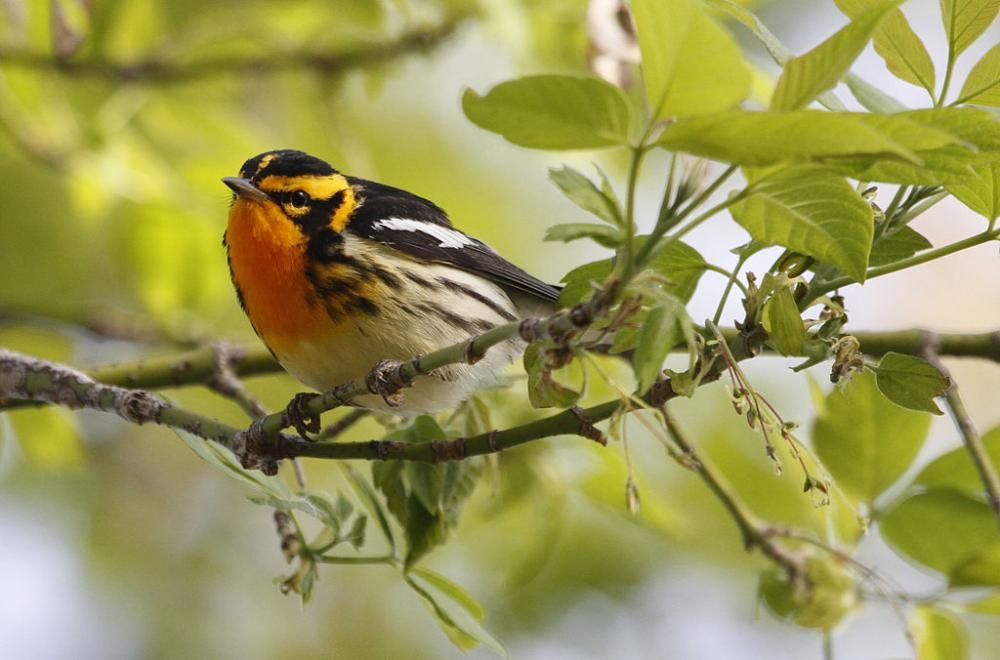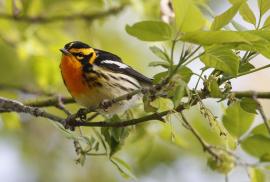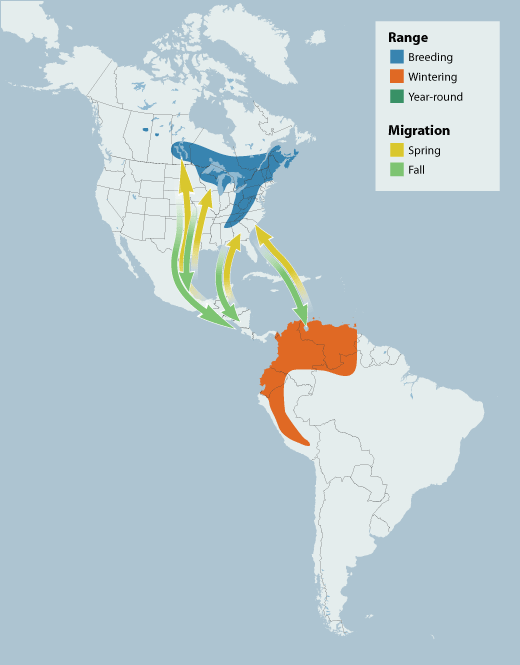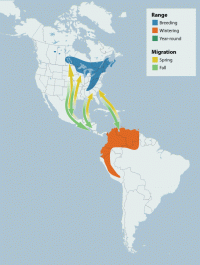Guide to Boreal Birds
This is an in-depth boreal species profile.
What is this?
This species is one of more than 30 birds selected for in-depth profiles. Find out why and see all selected boreal birds »
Overview
The most distinctive characteristics of the Blackburnian Warbler are its treetop ecology and the breeding male's color. One of a large genus of morphologically and ecologically similar warblers, the Blackburnian is the only one with orange in its plumage. The male's striking black-and-orange pattern makes some observers think of a miniature oriole. Blackburnian Warblers are usually found high in trees, even during migration, and are not readily noticed in the dense foliage unless their high-pitched song announces their presence. At times they may be detected at the ends of branches, picking among leaves for bugs or caterpillars. Its canopy nesting habits have defied many researchers' efforts to study its breeding ecology.
Description
5" (13 cm). Breeding male black and white with vivid orange throat, crown patch, and eyebrow; and large white wing patch; female similar, but has yellow throat. Back of both sexes boldly striped. Immature male similar to female.
Voice
Very thin and wiry, increasing in speed and rising to the limit of hearing, sleet-sleet-sleet-sleet-sleetee-sleeeee. Also tiddly-tiddly-tiddly-tiddly at same speed and pitch.
Nesting
4 brown-spotted white eggs in a twig nest lined with lichens, mosses, and hair, usually placed high in a large conifer.
Habitat
In most parts of its breeding range, the Blackburnian Warbler nests in mature coniferous and mixed forest and often occurs in highest densities in old-growth forests. Coniferous trees, whether spruce, balsam fir, pine, or hemlock, are an essential habitat component throughout the species range. At the end of the breeding season, young and adults often leave the conifers to forage in food-rich paper birches. As with other warblers, it may use virtually any woody habitat, and occasionally even herbaceous habitats, during migration. In winter it is found in high-altitude forests, woodlands, plantations, and treed pastures.
Range/Migration
The Blackburnian Warbler is primarily a nocturnal migrant. Fall and spring migration routes cover the eastern U.S., although spring migration seems to bypass the southeast coast. Migration appears to be fairly direct between the breeding grounds (described above) and the wintering grounds in the highlands of southern Central and northwestern South America, from Costa Rica to Venezuela and Peru. Birds at the western edge of the breeding range fly east before heading south in fall. The breeding grounds are vacated by September and most birds have left the U.S. by October. Peak fall migration dates are late August in central Minnesota and early September in northern West Virginia. Most individuals fly across the Gulf of Mexico but some travel overland along the Caribbean coast of Central America and a few traverse the Caribbean. Northbound in spring, the first birds reach the Gulf Coast in late March, northern states a month later, and Canada shortly thereafter.
Breeding
The Blackburnian Warbler nests across the southeastern boreal zone from east-central Saskatchewan to the Maritimes, with isolated populations in central Alberta and on the Alberta-Saskatchewan border. It may be extending its breeding range in western Canada. More than half of its global population is estimated to breed in Canada's boreal zone. Its breeding range extends south the length of the Appalachians and into the Great Lakes region. Much of what is known of this species' nesting ecology is similar to that of its close relatives. It forms seasonally monogamous pairs shortly after arriving on the breeding grounds in April or May; males arrive slightly ahead of females. Males sing from high, exposed perches and while foraging; dawn and dusk songs differ from midday songs. Nests are virtually always placed in conifers, especially hemlocks if available, usually well away from the trunk. As with its foraging behavior, it tends to nest higher than do other warblers, sometimes at heights approaching 80 feet (over 25 m). Often it is the only warbler nesting in the upper canopy. The cup nest of twigs, bark, etc. and lined with lichens, mosses, hair, and other soft materials is believed built only by the female. She lays and incubates three to five (usually four) eggs. The young hatch after about 12-13 days; the nestling period is unknown but probably on the order of ten days. Fledglings stay with their parents for some time after fledging, the family often splitting up after a few days, with some young accompanying each parent. Blackburnian Warblers never attempt more than a single brood in a year.
Diet/Feeding Behavior
The Blackburnian Warbler is primarily insectivorous year-round, though it supplements its diet with fruits in winter and during migration. Caterpillars (including spruce budworm), spiders, beetles, and mayflies are its main prey during the breeding season. It gleans food from small branches (less often from twigs and large branches) and leaf bases, hover-gleans from the undersides of foliage, and occasionally hawks flying insects. It often works its way outward along branches from base to tip, repeating the process on one branch after another. Despite its predilection for conifers when nesting, it forages extensively in nearby deciduous trees when they are available. It tends to forage higher in the canopy than do most co-occurring warbler species, thereby reducing competition; males do much of their foraging between singing bouts in the treetops while females forage closer to the nests somewhat lower. Outside the breeding season, it often joins mixed-species foraging flocks.
References
Blancher, P. 2003. The importance of Canada's boreal forest to landbirds. Canadian Boreal Initiative.
Chipley, R. M. 1980. Nonbreeding ecology of the Blackburnian Warbler. Pp. 309-317 in Migrant birds in the Neotropics (A. Keast and E. S. Morton, eds.). Smithson. Inst. Press, Washington, D.C.
Doepker, R. V., R. D. Earle, and J. J. Ozoga. 1992. Characteristics of Blackburnian Warbler, Dendroica fusca, breeding habitat in upper Michigan. Can. Field-Nat. 106:366-371.
MacArthur, R. H. 1958. Population ecology of some warblers of northeastern coniferous forests. Ecology 39:599-619.
Morse, D. H. 1967. The contexts of songs in the Black-throated Green and Blackburnian warblers. Wilson Bull. 79:62-72.
Morse, D. H. 1970. Ecological aspects of some mixed-species foraging flocks of birds. Ecol. Monogr. 40:119-168.
Morse, D. H. 1994. Blackburnian Warbler (Dendroica fusca). In The Birds of North America, No. 102 (A. Poole and F. Gill, eds.). The Academy of Natural Sciences, Philadelphia, and The American Ornithologists' Union, Washington, D.C.
Sauer, J. R., J. E. Hines, and J. Fallon. 2004. The North American Breeding Bird Survey, Results and Analysis 1966 - 2003. Version 2004.1. USGS Patuxent Wildlife Research Center, Laurel, MD.
Credits
Birding content provided by National Wildlife Federation/eNature, with support from Ducks Unlimited/The Pew Charitable Trusts.





